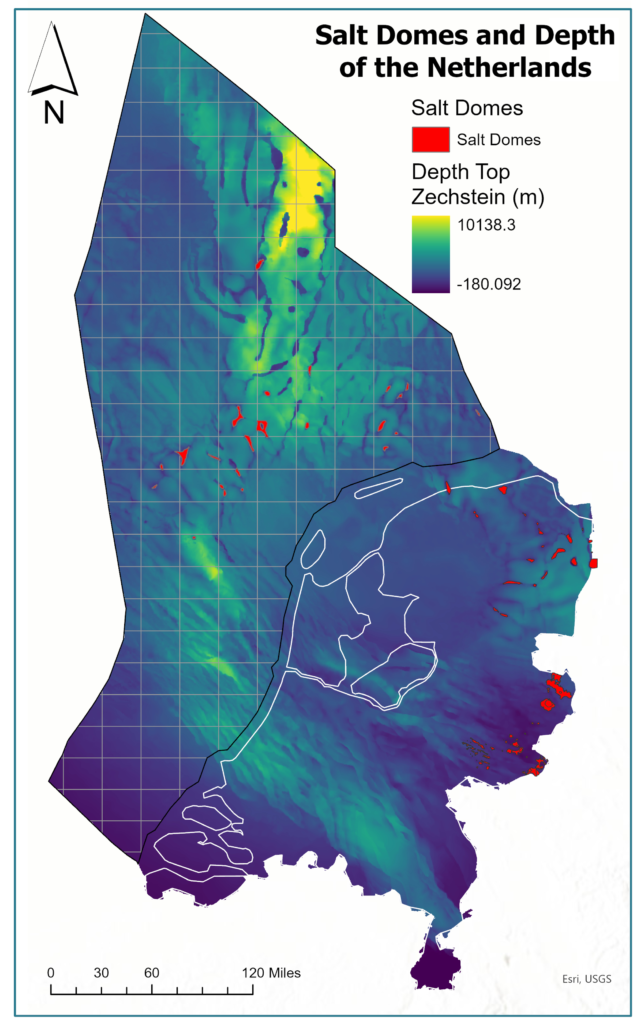intro
As a master’s student in Geological Sciences at the University of Texas at Austin, my research explores the intersection of geoscience, energy, sustainability, and environmental policy. I’ve contributed to a range of projects spanning hydrogen storage in geological formations, the regulatory challenges of green hydrogen deployment, regional climate action planning, and groundwater-surface water interactions in arid regions. My work has integrated geospatial data analysis, field data collection, and policy frameworks to address complex environmental and energy challenges. Below is a selection of research experiences that reflect my commitment to advancing low-carbon solutions and environmental resilience.
About my Current Research:
Hydrogen Storage Potential of Salt Domes in the Netherlands
Anna Romina Cervantes, Leopoldo M. Ruiz Maraggi, Lorena G. Moscardelli, Ander Martinez-Doñate
The University of Texas at Austin – Bureau of Economic Geology
As part of my graduate research at the University of Texas at Austin, I’m investigating the suitability of Netherlands salt dome formations for underground hydrogen storage. This work focuses on the geologic and technical parameters that influence the development of subsurface hydrogen infrastructure. Using GIS analysis, site screening criteria, and subsurface data interpretation, the project aims to estimate regional storage capacities and identify strategic locations that could support a future low-carbon hydrogen economy in the Netherlands.

Map of salt domes and depth to the top of the Zechstein formation in the Netherlands.
In progress…
Adapted from Kortekaas, et al., 2024.
Play 6 Zechstein. Accessed 02 17, 2025. https://www.geodeatlas.nl/pages/play-6-zechstein
Past Research:
Navigating the Permitting Landscape for Electrolyzer Deployment
U.S. Department of Energy – Energy Efficiency & Renewable Energy – Hydrogen & Fuel Cell Technologies Office
As part of the DOE’s Minority Educational Institution Student Partnership Program, I investigated the regulatory and permitting hurdles facing electrolyzer deployment in the U.S., with a special focus on water-related constraints. I analyzed project case studies, mapped permitting pathways, and proposed best practices to streamline the implementation of green hydrogen infrastructure.
Climate Action Planning in Border Communities
City of El Paso, TX – Office of Climate & Sustainability
I contributed to the development of El Paso’s first regional climate action plan through research, data synthesis, and community outreach. This work supported a broader EPA Climate Pollution Reduction Grant and helped lay the foundation for policy that addresses environmental justice and resilience in underserved communities.
Hydrogen Storage in Existing Natural Gas Storage Sites: A Geologic Perspective
U.S. Department of Energy – Pacific Northwest National Laboratory – Mickey Leland Energy Fellowship
At PNNL, I collaborated with a research team to assess the viability of hydrogen storage within existing natural gas reservoirs. My work involved identifying geologic and engineering parameters that influence storage efficiency, developing a screening methodology for potential storage sites, and presenting findings at a DOE technical forum. This research contributed to advancing hydrogen as a sustainable energy carrier.
Salinity and Agricultural Water Use in the Rio Grande
UTEP Senior Capstone Project
For my undergraduate capstone, I worked with a team to examine salinity variations along the Rio Grande and their impact on agricultural productivity. We used historical data, GIS analysis, and stakeholder interviews to explore solutions such as desalination and upstream flow regulation to improve water quality for irrigation.
Geophysical Techniques for Groundwater Monitoring
UTEP Field Geophysics Course
In a field-based course, I applied geophysical methods such as resistivity, seismic refraction, and GPR to monitor groundwater systems in Valles Caldera, New Mexico. The experience deepened my understanding of subsurface hydrology and the practical application of geophysical tools in environmental investigations.
Population Genetics of Carex bigelowii in the Arctic
Undergraduate Research – UTEP Department of Biological Sciences
I studied the genetic diversity of the Arctic plant Carex bigelowii to understand how climate change may be altering vegetation patterns. My role involved field data processing, DNA extraction, and PCR analysis. I presented this work at campus research symposiums, highlighting the implications for Arctic ecosystem resilience.